Bioengineering’s Golecki Uses Soft Robotics to Hook Students on Biomedical Engineering…STEM
November 13, 2019
Working with students—opening their eyes to the possibilities—empowering students to believe that they deserve a seat at the table is really important to me.” – Holly Golecki
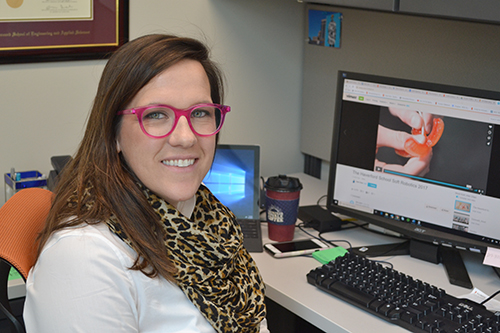
Bioengineering Assistant Professor Holly Golecki
Holly Golecki, a new Bioengineering (BioE) Assistant Professor, is passionate about biomedical engineering, soft robotics, and using the two to pique young people’s interest in STEM. She’s particularly interested in steering girls onto the engineering pipeline.“I want to empower women and young girls to feel like they deserve a seat at the table in any engineering discipline,” she explains.
Golecki’s field of research is robotics, specifically robots made of soft, compliant materials, like silicone, which can be worn on or inside the body—perfect for medical devices. In fact, soft robotics is one reason Bioengineering draws a large number of women—many of whom aspire to careers where they can make a difference in people’s lives. It’s also the reason BioE at Illinois enrolls such a high percentage of young women—similar to or even slightly higher than the national percentage. Golecki’s theory is that since Bioengineering provides students with a wide range of projects that directly help patients, it can be used to hook younger girls into robotics.
Which brings up another area—Golecki’s research in engineering education. For instance, one question she’s interested in answering is this: “How do we get young people interested in and engaged in engineering from a young age?” Golecki believes she has the answer. She sees soft robotics as an entry into the engineering pipeline: soft robotics, to biomedical engineering, to engineering.
“Soft robotics has lots of applications for healthcare, such as an exosuit to help someone walk, or a heart sleeve to help someone's heart pump,” she explains. “So I think if we can engage girls that way to say, ‘Hey, come to robotics! It's a biomedical thing,’ I think we'll hook them and then teach them the fundamentals of engineering so that they feel empowered to study any engineering discipline.”
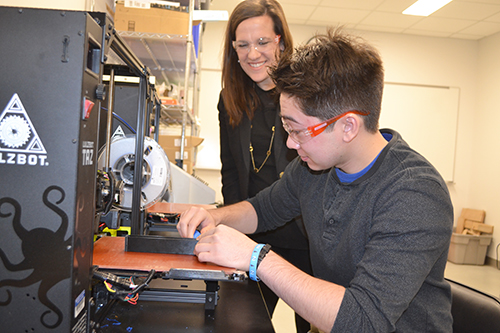
Holly Golecki (left) watches as BioE senior Kyle Ritchie prepares to cast a catheter in the mold he designed.
One of the newest members of BioE’s teaching faculty, Golecki also preaches soft robotics to her college students. She’s currently teaching two courses. One is BioE 100, an introduction to bioengineering for incoming freshmen. Her second course, BioE 435, is a two-semester senior design course that begins in the fall and lasts through the spring semester.
And, since BioE 435 is a projects course, a key component is, of course, students’ senior projects. First, students chose something they’re interested in. For instance, they got to pick from 14 different projects suggested by industry representatives, MDs from Carle, even BioE faculty. These folks presented their pitches to the students, who then voted to rank projects they most wanted to work on. Based on their top choices, Golecki then formed the teams.
Students have been working on their projects for the entire fall 2019 semester. The first checkpoint is scheduled for the semester’s end, to help keep students on track. Teams must submit their prototype, plus present at a poster session. Then, on the last day of class the spring semester is a final presentation, where students present and demonstrate their creations.
What are some of the projects? One team has been working on a project Golecki herself pitched: degradation rates of gelatin-based robots. “Cause right now, they're made out of gelatin gummy bears, and they dissolve in 15 minutes,” she explains. What she’s shooting for is a device designed to degrade at a specific rate that could be implanted in someone’s body. She elaborates on the need and how it might work.

A BioE435 student shows Holly Golecki (left) an image of the covered equine uterine swab she and her teammates are designing.
Golecki relates that a woman at MIT made a heart sleeve that fits right over someone’s heart that, when it actuates, forces a person’s heart to contract. However, because the device is made out of silicone, at some point after it's implanted, it would need to be taken out again.
“My thought is, we could make it out of gelatin and cross-link it so that it is stable for a while in the heart, and you could tune how much crosslinker you put in,” she explains. “You can change how long it will stay intact, and it will help support the heart, maybe after surgery, and then degrade away.” With her degrading device, the patient wouldn’t need a second heart surgery to remove the device.
The crosslinker to which she’s referring is transglutaminase or meat glue—the stuff that makes Spam stick together. “You can buy it on Amazon,” she continues. “So it's easily accessible.”
Not only is it easily accessible, it’s also inexpensive and edible. “It’s technically edible,” she qualifies. “Maybe people don't really want to eat it.” She mentions edible, because the project could also be used for candy or a food application. “That's all over the place,” she says, referring to the various areas the degrading, gelatin-based robots address. “But that's Material Science, food, and robotics.”
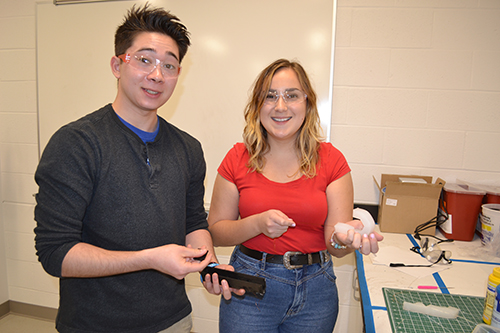
Kyle Ritchie (left) exhibits the mold he designed, while Stephanie Zimbru demonstrates a prototype of their flex tip catheter.
Another team, comprised of Kyle Ritchie and Stephanie Zimbru, is creating a flex tip catheter that moves in one direction. They modeled it using silicone and soft robotics principles they learned about from Golecki. Plus, the fact that these projects might also be used to help people someday was kind of the icing on the cake, not just for her students, but for Golecki as well. That’s one reason teaching students about soft robotics is one of her passions.
While her work at Illinois is, of course, with college students, in the future, Golecki also hopes to be able to work with younger students on a volunteer basis. Her passion for working with younger students makes perfect sense, given that she used to be a high school teacher. In fact, she taught high school for five years while finishing up her PhD at Harvard. Goleki’s dream for outreach while at Illinois is to mentor an all-girl robotics team, helping younger students, such as high school, or even better yet, middle school girls, do soft robotics projects.
For instance, one group with a built-in, all-female population that she’s looking into is the Campus Middle School for Girls. While the school already has a robotics team working with traditional hard robotics, she hopes to introduce them to soft robotics. Another option she’s considering is VEX, which has a girl-power initiative aimed at starting all-girl teams or at least teams that have girls on them.
Golecki’s desire to target girls probably makes sense too, given that she taught high school and was director of robotics at an all-boys private school. It was there, when participating in Vex robotics competitions, that she noticed how few girls were involved in the competitions. While she says a lot of effort is being made to engage girls in robotics, and some progress has been made, there still aren’t enough girls involved.
While teaching high school, Golecki also ran a soft robotics mini research group for middle school students—all boys too. Based on the experience, she believes girls would enjoy building soft robotic devices as well. She adds that although the field is brand new, there are lots of resources to help young people engage in software biotics; the materials are very inexpensive, plus there are also online resources where kids can experiment. One project, complete with a full set of instructions, involves making a bionic finger. According to Golecki, it’s a project middle to high-school-aged students could very easily make.
In fact, some of the projects her middle school research group did might even be more suitable for girls. For instance, in a collaboration with Lilly Pulitzer, which manufactures fashions made of brightly colored floral patterns and neon colors, her group actually met with their fabrics team to discuss what technology needs the manufacturer might have. So her group designed wearable technology projects incorporating sensors and LEDs into the manufacturer’s clothing. One project was a cell phone contact charger.
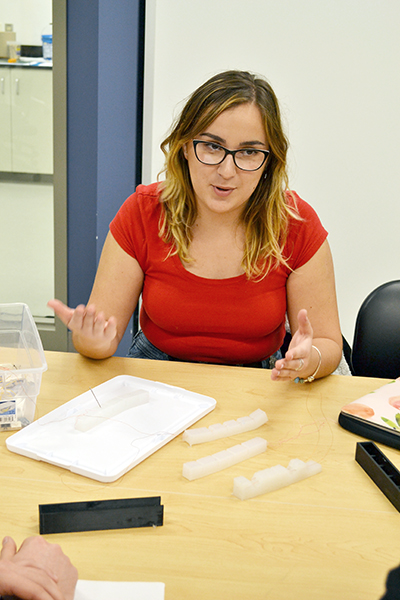
Illinois BioE senior Stephanie Zimbru shows several flex tip catheters she and Kyle Ritchie have created to date.
“So imagine if you could just have a contact charger in your pocket, and maybe within the pattern of the clothing there's a solar panel embedded so that it could be charging your phone?” Golecki suggests. How convenient would something like that be for those of us whose batteries are always low because we use our phones not just to communicate with each other and to play, but to work, bank, make purchases, and research online?
So her group made both a vest and a beach bag incorporating that technology. Plus, one dress they designed had embedded LEDs that would twinkle as the wearer would move—kind of like a starry night—all projects girls would love.
Golecki’s main outreach goal is to use soft robotics to attract girls to the engineering pipeline. “What I really want to do is teach fundamental mechanical engineering, electrical engineering, programming principles through that avenue. So hook them with the biomedical applications, but embed a lot of the fundamental, traditional engineering disciplines within there to empower them.” Her goal is for girls “to be able to have confidence that they know just as much as the boys do when they get to university level.”
Given her passion for working with youth, why the move to teaching college? For one, Golecki yearned to work with students who have more of a technical background. She explains that while she was able to do “some cool and interesting things,” with high school students, she had to teach them everything, sometimes beyond what they could really comprehend.
So she says teaching at the university level challenges her in a positive way to push harder on the technical side, which she likes. “The students are open to experimentation, and project-based learning is kind of even a new thing at the university level. So I can do a lot of the same things, but with more technical rigor, which is what I love.”
While Golecki might say college kids are better trained, she would probably say that younger students can be just as innovative. In fact, Golecki recalls another opportunity her high school students had as a result of their innovation.
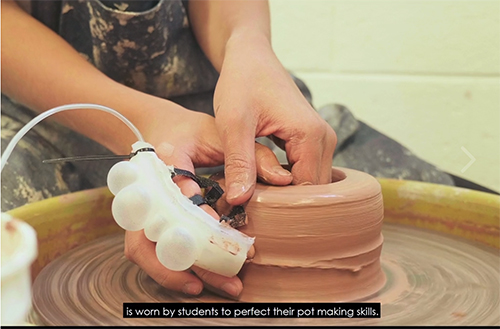 Watch a video about how her high school students created the glove. Image and video courtesy of Intel Chen.)"/>
Watch a video about how her high school students created the glove. Image and video courtesy of Intel Chen.)"/>The ceramics teacher wears a sensor while throwing a pot in order to measure the pressure he’s putting on the clay. (Watch a video about how her high school students created the glove. Image and video courtesy of Intel Chen.)
A ceramics teacher had invited her high schoolers to design a glove students could wear for training purposes, given that there are some nuanced movements used when throwing a pot that are difficult to communicate. First her students measured how much force the teacher was applying by having him wear a force sensor on his hands while throwing a pot. Then they wrote an algorithm that conveyed the degree of force used to a soft robotic glove so it could then guide a student's hand while doing ceramics. The glove would inflate, pushing the student’s fingers and actually training their brain to know how hard to push when throwing a pot.
To her and her students’ amazement, some folks from NASA saw a video of their project online, called them, and invited them to NASA last spring. “It was crazy,” Golecki recalls, telling her students, ‘You don't even understand the opportunity that you have right now.’” So she and her students visited NASA for four days for a big brainstorming session about ways soft robotics could be used for space exploration.
“It was cool cause giving them the opportunity, the space to innovate, they actually can… which I thought was really interesting,” she says, adding, “You don't have to be in graduate school to innovate.”
Another group Golecki would like to work with down the road is teachers. She hopes to mentor them, “teaching them the fundamental principles that they can tie to their curriculum.” A former teacher, she knows that middle and high school teachers have to address certain things, but there's only so much time. So she hopes to help teachers tie these types of projects to fundamental concepts that have to be covered within the curriculum. Her goal is to package some things that they could easily use. “Being a former teacher myself, I understand the strain on teachers and the time constraints,” she admits. “So I feel like I can help that population, because I understand what it's like.” In addition, she would also love to hold a workshop to teach teachers how to adapt university-level curriculum for high school and middle school students.
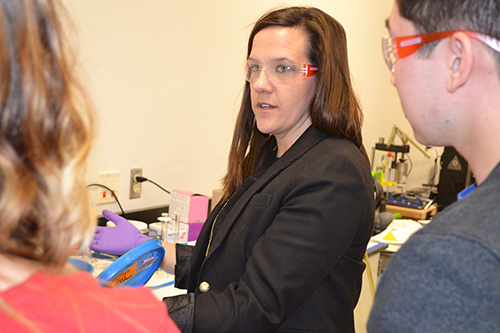
Holly Golecki (center) explains to two of her students the benefits of certain kinds of silicone.
Golecki, who recently finished up her PhD at Harvard in bioengineering, with a bio materials focus, while her undergraduate degree was in Material Science, is also interested in doing soft robotics using another kind of soft material: food. Regarding her diverse research interests, she explains, "You can kind of be anywhere today.". For instance, one high school course she’s taught involves phase transformations and using food as a building material. “So using food as a way to teach non-scientists science or to teach elementary chemistry and material science concepts through food,” she adds.
So in addition to making soft robots out of gummy bears, which she says are not only fully edible but can bend, she envisions applying her soft robotics skills to create more soft-robotics-enabled, exotic foods in the future.
“Since I love food, and material science, and soft robotics, my dream is to collaborate with someone in culinary arts,” she says. For example, she envisions designing a dessert that, to begin with, looks like a flower that hasn't yet bloomed. When it’s served, however, the patron would cut it with a knife to release the valve and, because it's pneumatically actuated, or filled with air, it would then “bloom.”
“Molecular gastronomy,” she explains. “That kind of food is entertainment. So that's one thing that I really would love to do.” One can envision seeing Golecki on some Food Channel dessert competition down the road, wowing the judges with one of her creations. One can also envision her dream dessert as the pièce de résistance at some high-level restaurant.
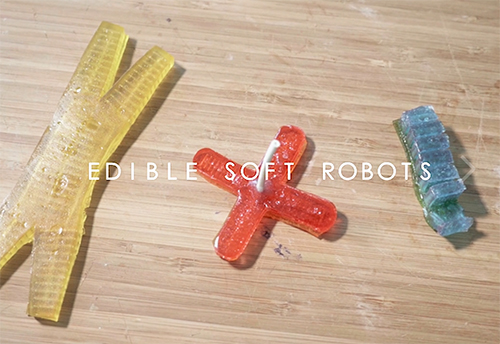 Edible soft robots Golecki's high school students created using gummy bears.
(Watch a video about the edible soft robot project Golecki’s students created [Image and video courtesy of Intel Chen].)
Edible soft robots Golecki's high school students created using gummy bears.
(Watch a video about the edible soft robot project Golecki’s students created [Image and video courtesy of Intel Chen].)Another group Golecki hopes to impact is younger children. For instance, she’s encouraging her BioE students to do soft-robotics-related exhibits for Engineering Open House. One idea she suggested was soft robots made out of gummy bears, which she’s seen used effectively during an outreach. She describes an edible robotics exhibit her high school students presented at the Materials Research Society Annual Meeting. “So they were talking to scientists and engineers in between sessions in an informal way…They had a poster, and it was amazing the opportunities that they had because of doing robotics, because it's new and novel and sort of interesting.” Kids who attended the conference with their parents appreciated her students’ booth as well. “So it was super cool,” she indicates. “They were checking out the robots, and they're eating them, and it was cool. So I thought it'd be perfect for Engineering Open House.”
No matter the age group she’s working with, Golecki loves teaching. “It's exciting!” she admits. “I love waking up and going to work every day. It's fun. It almost feels like I get to play at work. Coming up with new ideas, being on the cutting edge, figuring out more efficient ways to do things using materials and robotics is just really exciting to me.”
Plus, a first-generation college student, Golecki says she got to where she is today because of awesome mentors that she had along the way. So she wants to give back. “So I just want to pay it forward and be that mentor for other students,” she acknowledges.
Author: Betsy Innes, Communications Specialist, I-STEM Education Initiative. Photographer: Betsy Innes (unless otherwise noted).
For more I-STEM articles about Bioengineering projects courses, see:
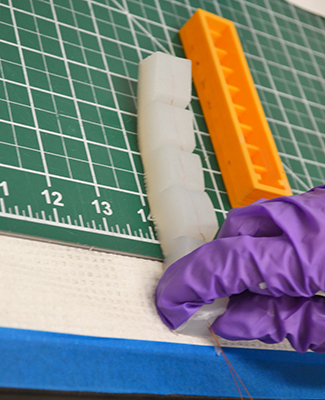
A prototype of BioE seniors Ritchie and Zimbru's flex tip catheter.
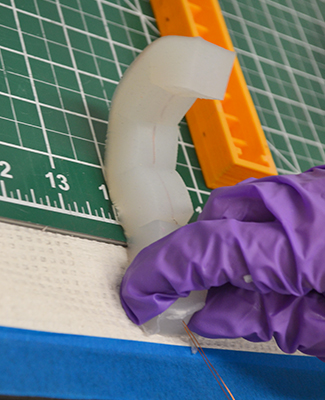
The catheter partially flexed.
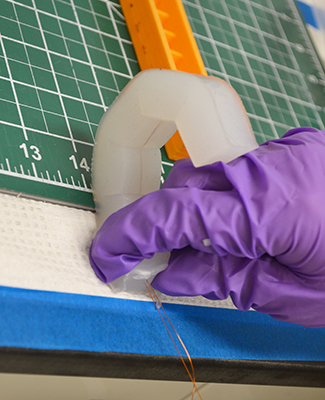
The catheter fully flexed.
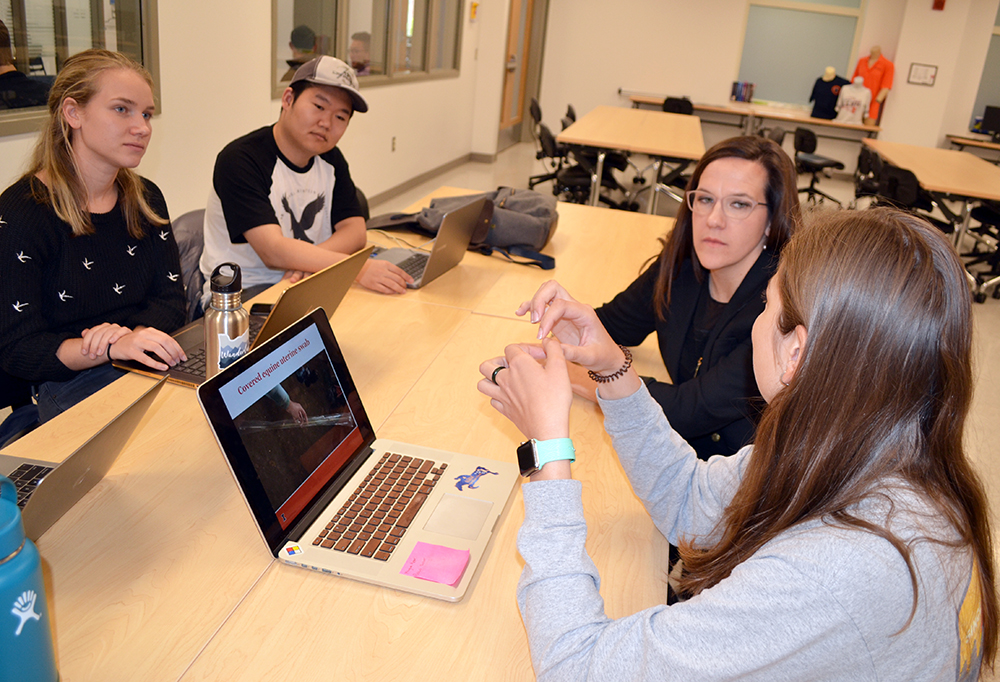
Holly Golecki (second from the right) meets with a team of students during one of BioE 435’s labs.













.jpg)
















